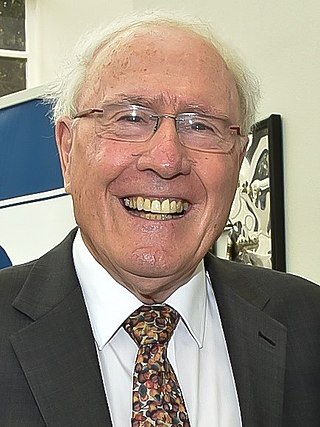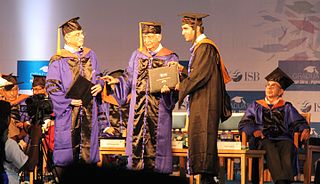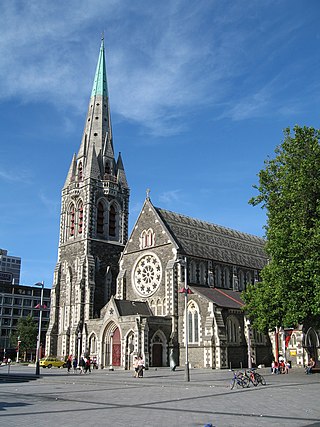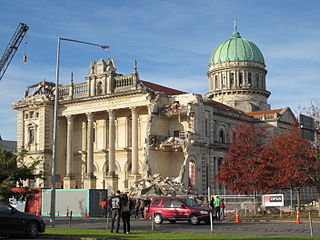
The University of Canterbury is a public research university based in Christchurch, New Zealand. It was founded in 1873 as Canterbury College, the first constituent college of the University of New Zealand. It is New Zealand's second-oldest university, after the University of Otago, which was founded four years earlier, in 1869.

Sir Geoffrey Winston Russell Palmer is a New Zealand lawyer, legal academic, and former politician, who was a member of Parliament from 1979 to 1990. He served as the 33rd prime minister of New Zealand for a little over a year, from August 1989 until September 1990, leading the Fourth Labour Government. As minister of justice from 1984 to 1989, Palmer was responsible for considerable reforms of the country's legal and constitutional framework, such as the creation of the Constitution Act 1986, New Zealand Bill of Rights, Imperial Laws Application Act, and the State Sector Act. He served as president of the New Zealand Law Commission, from 2005 to 2010.

A convocation is a group of people formally assembled for a special purpose, mostly ecclesiastical or academic.

Gerard Anthony Brownlee is a New Zealand politician and the 32nd speaker of the New Zealand House of Representatives. He was first elected as a member of the New Zealand House of Representatives for Ilam in 1996, representing the National Party. He became a list MP in 2020.

Sir John Phillip Key is a New Zealand retired politician who served as the 38th prime minister of New Zealand from 2008 to 2016 and as leader of the New Zealand National Party from 2006 to 2016. After resigning from both posts in December 2016 and leaving politics, Key was appointed to the board of directors and role of chairman in several New Zealand corporations. After his father died when he was eight, Key was raised by his single mother in a state-house in the Christchurch suburb of Bryndwr. He attended the University of Canterbury and graduated in 1981 with a Bachelor of Commerce. He began a career in the foreign exchange market in New Zealand before moving overseas to work for Merrill Lynch, in which he became head of global foreign exchange in 1995, a position he would hold for six years. In 1999 he was appointed a member of the Foreign Exchange Committee of the Federal Reserve Bank of New York until leaving in 2001.

ChristChurch Cathedral, also called Christ Church Cathedral and (rarely) Cathedral Church of Christ, is a deconsecrated Anglican cathedral in the city of Christchurch, New Zealand. It was built between 1864 and 1904 in the centre of the city, surrounded by Cathedral Square. It became the cathedral seat of the Bishop of Christchurch, who is in the New Zealand tikanga of the Anglican Church in Aotearoa, New Zealand and Polynesia.

The constitution of New Zealand is the sum of laws and principles that determine the political governance of New Zealand. Unlike many other nations, New Zealand has no single constitutional document. It is an uncodified constitution, sometimes referred to as an "unwritten constitution", although the New Zealand constitution is in fact an amalgamation of written and unwritten sources. The Constitution Act 1986 has a central role, alongside a collection of other statutes, orders in Council, letters patent, decisions of the courts, principles of the Treaty of Waitangi, and unwritten traditions and conventions. There is no technical difference between ordinary statutes and law considered "constitutional law"; no law is accorded higher status. In most cases the New Zealand Parliament can perform "constitutional reform" simply by passing acts of Parliament, and thus has the power to change or abolish elements of the constitution. There are some exceptions to this though – the Electoral Act 1993 requires certain provisions can only be amended following a referendum.

Roger Sutton is a business leader in Christchurch, New Zealand. He was chief executive of power lines company Orion New Zealand Limited from 2003 until 13 June 2011, when he commenced as CEO of the Canterbury Earthquake Recovery Authority. He resigned in 2014 after being found guilty of serious misconduct by the State Services Commission.

Sir Robert John Parker is a former New Zealand broadcaster and politician. He served as Mayor of Christchurch from 2007 to 2013.
Toka Tū Ake EQC, also known as the Earthquake Commission,, is a New Zealand Crown entity that invests in natural disaster research and education as well as providing natural disaster insurance to residential property owners. In March 2022, a bill was introduced to, among other changes, update the name of the Earthquake Commission to Toka Tū Ake – Natural Hazards Commission.
The 2010 Canterbury earthquake struck the South Island of New Zealand with a moment magnitude of 7.1 at on 4 September, and had a maximum perceived intensity of X (Extreme) on the Mercalli intensity scale. Some damaging aftershocks followed the main event, the strongest of which was a magnitude 6.3 shock known as the Christchurch earthquake that occurred nearly six months later on 22 February 2011. Because this aftershock was centred very close to Christchurch, it was much more destructive and resulted in the deaths of 185 people.

A major earthquake occurred in Christchurch on Tuesday 22 February 2011 at 12:51 p.m. local time. The 6.2 earthquake struck the Canterbury region in the South Island, centred 6.7 kilometres (4.2 mi) south-east of the central business district. It caused widespread damage across Christchurch, killing 185 people in New Zealand's fifth-deadliest disaster.

The Canterbury Earthquake Recovery Authority was the public service department of New Zealand charged with coordinating the rebuild of Christchurch and the surrounding areas following the 22 February 2011 earthquake. After it was disestablished on 18 April 2016, CERA's functions were taken over by a variety of other agencies.

The June 2011 Christchurch earthquake was a shallow magnitude 6.0 earthquake that occurred on 13 June 2011 at 14:20 NZST. It was centred at a depth of 7 km (4.3 mi), about 5 km (3 mi) south-east of Christchurch, which had previously been devastated by a magnitude 6.2 MW earthquake in February 2011. The June quake was preceded by a magnitude 5.9 ML tremor that struck the region at a slightly deeper 8.9 km (5.5 mi). The United States Geological Survey reported a magnitude of 6.0 Mw and a depth of 9 km (5.6 mi).
The Universal Periodic Review (UPR) is a state monitoring mechanism of the United Nations Human Rights Council (HRC). It was established by General Assembly resolution 60/251 in 2006 to periodically review the protection and promotion of human rights in each of the 193 United Nations (UN) Member States. New Zealand has been reviewed twice via the UPR in 2009 and 2014.

Fracking has been carried out in New Zealand for over 27 years, mostly in Taranaki and also in coal seams in Waikato and Southland. Concerns have been raised about its negative effects and some local government jurisdictions have called for a moratorium on fracking but this has been rejected by the government. The environmental effects of fracking are regulated by the Resource Management Act (RMA) through the requirement for resource consents.

Deon William Swiggs is a New Zealand politician serving as the Environment Canterbury Councillor representing the Christchurch West/Ōpuna Regional Constituency. He previously served as the Christchurch City Councillor representing the Central ward from 2016 to 2019. Prior to Swiggs being elected, he was most well known for his participation in Rebuild Christchurch, an organisation founded after the 2010 Canterbury earthquake.

The Canterbury Earthquake Recovery Act 2011 was a New Zealand statute that repealed the Canterbury Earthquake Response and Recovery Act 2010 and set out measures to respond to the impact of the Canterbury earthquakes, and in particular the February 2011 Christchurch earthquake.
Elizabeth Toomey is a New Zealand law academic. She is currently a full professor at the University of Canterbury.

Norman Kirk Park is a recreational space on the east side of Kaiapoi which is a town in the Waimakariri District of Canterbury, New Zealand. Norman Kirk Park was built on former red zone land that was a residential neighbourhood prior to the Canterbury earthquakes of 2010 and 2011. Norman Kirk Park consists of a dog park, a nature reserve, sports fields, and a BMX track.















